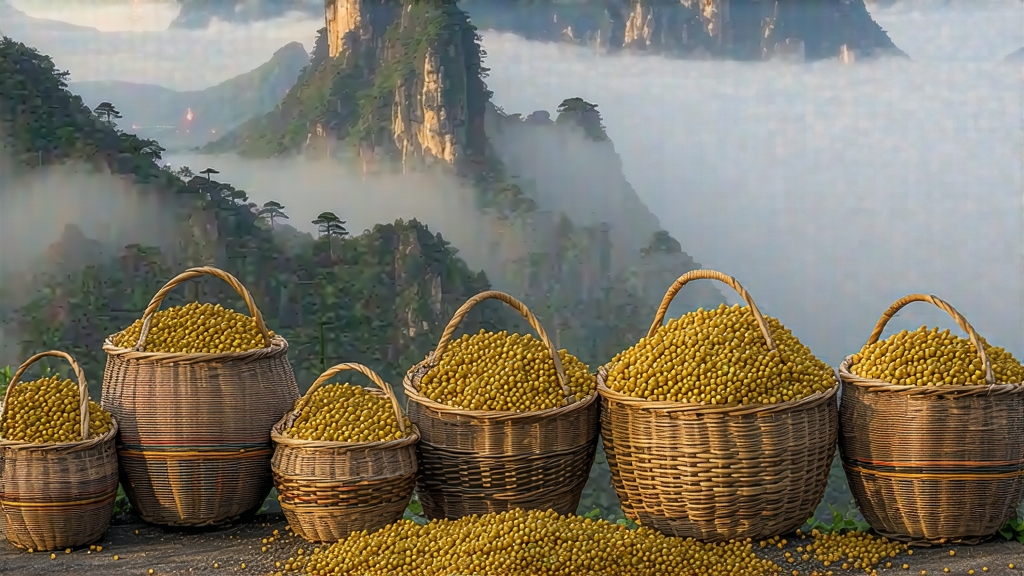
Tucked high in the mist-veiled Dabie Mountains of western Anhui Province, Huoshan Huangya has quietly captivated Chinese emperors, Tang-dynasty poets, and modern tea aesthetes for more than fourteen centuries. Unlike its better-known cousins Longjing or Tieguanyin, this “yellow bud” tea remains a semi-hidden gem, its production so micro-regional and its craft so labor-intensive that fewer than 30,000 kg of authentic leaf reach the market each year. To understand why Huoshan Huangya is considered the benchmark of China’s smallest tea category, one must follow the leaf from Tang-era tribute records to the bamboo-lined curing rooms where master artisans still coax green leaf into liquid gold.
Historical backdrop
The first written reference appears in the Shennong Bencaojing (Divine Farmer’s Materia Medica, 1st century CE), but Huoshan Huangya’s imperial stature begins in Tang dynasty (618-907) when the county of Huoshan was designated a “tea tax prefecture.” Caravans carried compressed cakes of the yellow-green leaf along the Silk Road; surviving ledgers from 780 CE list “Huoshan Yellow Cake” at four times the price of ordinary brick tea. By the Ming dynasty the leaf had evolved into the loose, bud-centric style we recognize today, and in 明朝永乐年间 (Yongle era 1403-1424) it entered the palace as one of only six teas granted the title gongcha (“tribute tea”). Legend claims the Kangxi Emperor (r. 1661-1722) so prized the tea’s honeyed aroma that he exempted Huoshan farmers from grain tax during years of frost damage.
Terroir and cultivar
Huoshan county lies at 31° N latitude, where the Dabie range funnels cool, mineral-rich air into narrow valleys. Elevation ranges from 300 to 800 m; diurnal temperature swings can exceed 15 °C in early April, slowing bud growth and concentrating amino acids. The soil is a yellow-brown lateritic loam, slightly acidic (pH 5.2–5.6) and laced with granite grit that radiates daytime heat back to the bushes at night. The traditional cultivar is Huoshan Da Bai Hao (“Big White Down”), a seed-propagated landrace whose one-bud-one-leaf pluck can reach 3.5 cm yet remains tender enough to fold without tearing. Its downy reverse side gives the finished tea a silvery shimmer that connoisseurs call “golden needle frost.”
Harvest calendar
Authentic Huangya is picked only seven mornings each year, beginning when 5 % of the garden’s buds reach “sparrow’s tongue” length (2.0–2.5 cm) but before the Qingming festival. Experienced pickers use a “twist-lift” motion that snaps the bud at the first internode without fingernail bruising. Leaves must reach the village workshop within two hours; baskets are lined with thin bamboo sheaths to prevent compression heat.
Craft: the secret of menhuang
What separates yellow tea from green is the proprietary “sweltering” or menhuang (闷黄) step—part enzymatic oxidation, part non-enzymatic Maillard reaction—executed while the leaf is still warm from fixation. Huoshan masters divide menhuang into three micro-stages:
-
Chu men (初闷) – Immediately after kill-green in 160 °C woks, the leaf is piled 8 cm deep inside bamboo trays lined with wet cotton cloth. Internal temperature drifts from 55 °C to 42 °C over 40 minutes; polyphenol oxidase activity drops 60 %, but peroxidase lingers, creating the tea’s signature yellow pigment (theaflavins-3-gallate).
-
Zhuan men (转闷) – Following the first rolling, leaf is restacked in 5 cm layers and slid into a pine-fired oven at 50 °C for 2.5 hours. Artisans “read” the pile’s aroma shift from fresh cucumber to steamed chestnut; when the edge buds turn primrose yellow, the cloth is lifted for a 15-minute flash-cool.
-
Fu men (复闷) – After final shaping, leaf is wrapped in kraft paper parcels and buried under charcoal ash at 38 °C overnight (8–10 h). This slow anneal reduces grassy vol